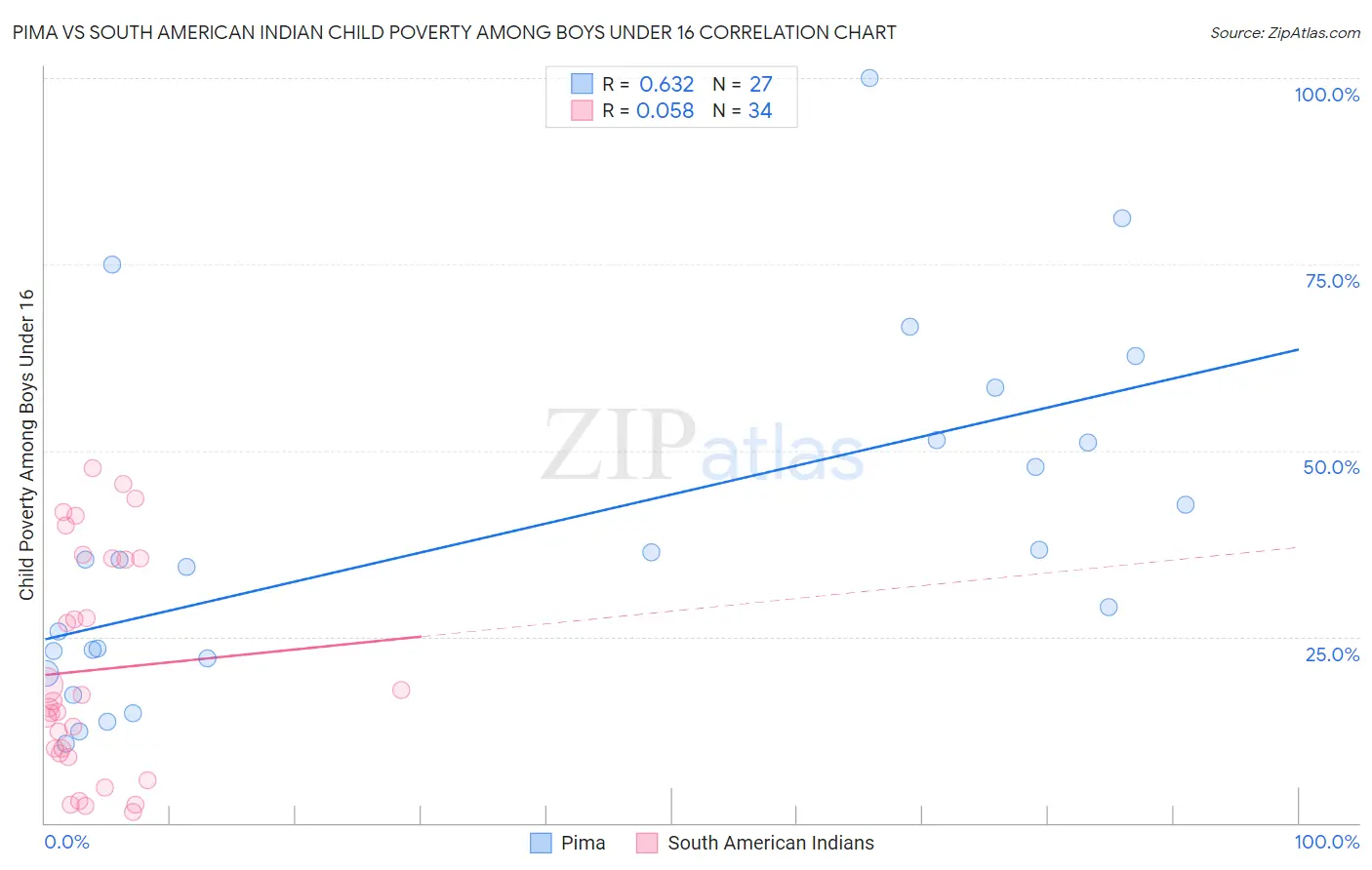Pima vs South American Indian Child Poverty Among Boys Under 16
COMPARE
Pima
South American Indian
Child Poverty Among Boys Under 16
Child Poverty Among Boys Under 16 Comparison
Pima
South American Indians
29.7%
CHILD POVERTY AMONG BOYS UNDER 16
0.0/ 100
METRIC RATING
342nd/ 347
METRIC RANK
16.5%
CHILD POVERTY AMONG BOYS UNDER 16
44.3/ 100
METRIC RATING
181st/ 347
METRIC RANK
Pima vs South American Indian Child Poverty Among Boys Under 16 Correlation Chart
The statistical analysis conducted on geographies consisting of 61,443,182 people shows a significant positive correlation between the proportion of Pima and poverty level among boys under the age of 16 in the United States with a correlation coefficient (R) of 0.632 and weighted average of 29.7%. Similarly, the statistical analysis conducted on geographies consisting of 163,628,947 people shows a slight positive correlation between the proportion of South American Indians and poverty level among boys under the age of 16 in the United States with a correlation coefficient (R) of 0.058 and weighted average of 16.5%, a difference of 79.8%.

Child Poverty Among Boys Under 16 Correlation Summary
| Measurement | Pima | South American Indian |
| Minimum | 10.7% | 1.4% |
| Maximum | 100.0% | 47.7% |
| Range | 89.3% | 46.2% |
| Mean | 38.9% | 20.5% |
| Median | 35.3% | 15.9% |
| Interquartile 25% (IQ1) | 22.0% | 9.4% |
| Interquartile 75% (IQ3) | 51.5% | 35.4% |
| Interquartile Range (IQR) | 29.4% | 26.0% |
| Standard Deviation (Sample) | 23.1% | 14.7% |
| Standard Deviation (Population) | 22.6% | 14.4% |
Similar Demographics by Child Poverty Among Boys Under 16
Demographics Similar to Pima by Child Poverty Among Boys Under 16
In terms of child poverty among boys under 16, the demographic groups most similar to Pima are Navajo (30.3%, a difference of 1.8%), Yuman (30.6%, a difference of 3.0%), Immigrants from Yemen (28.9%, a difference of 3.1%), Tohono O'odham (31.6%, a difference of 6.1%), and Lumbee (31.9%, a difference of 7.3%).
| Demographics | Rating | Rank | Child Poverty Among Boys Under 16 |
| Apache | 0.0 /100 | #333 | Tragic 24.5% |
| Blacks/African Americans | 0.0 /100 | #334 | Tragic 24.5% |
| Yup'ik | 0.0 /100 | #335 | Tragic 24.7% |
| Sioux | 0.0 /100 | #336 | Tragic 25.3% |
| Cheyenne | 0.0 /100 | #337 | Tragic 25.8% |
| Hopi | 0.0 /100 | #338 | Tragic 25.9% |
| Houma | 0.0 /100 | #339 | Tragic 26.2% |
| Crow | 0.0 /100 | #340 | Tragic 26.3% |
| Immigrants | Yemen | 0.0 /100 | #341 | Tragic 28.9% |
| Pima | 0.0 /100 | #342 | Tragic 29.7% |
| Navajo | 0.0 /100 | #343 | Tragic 30.3% |
| Yuman | 0.0 /100 | #344 | Tragic 30.6% |
| Tohono O'odham | 0.0 /100 | #345 | Tragic 31.6% |
| Lumbee | 0.0 /100 | #346 | Tragic 31.9% |
| Puerto Ricans | 0.0 /100 | #347 | Tragic 32.8% |
Demographics Similar to South American Indians by Child Poverty Among Boys Under 16
In terms of child poverty among boys under 16, the demographic groups most similar to South American Indians are Lebanese (16.6%, a difference of 0.11%), Hawaiian (16.5%, a difference of 0.14%), Hungarian (16.5%, a difference of 0.34%), Scotch-Irish (16.5%, a difference of 0.36%), and Kenyan (16.6%, a difference of 0.38%).
| Demographics | Rating | Rank | Child Poverty Among Boys Under 16 |
| Uruguayans | 50.0 /100 | #174 | Average 16.4% |
| Immigrants | Syria | 49.0 /100 | #175 | Average 16.5% |
| Whites/Caucasians | 48.2 /100 | #176 | Average 16.5% |
| Ethiopians | 47.8 /100 | #177 | Average 16.5% |
| Scotch-Irish | 47.5 /100 | #178 | Average 16.5% |
| Hungarians | 47.3 /100 | #179 | Average 16.5% |
| Hawaiians | 45.5 /100 | #180 | Average 16.5% |
| South American Indians | 44.3 /100 | #181 | Average 16.5% |
| Lebanese | 43.3 /100 | #182 | Average 16.6% |
| Kenyans | 41.0 /100 | #183 | Average 16.6% |
| Celtics | 40.6 /100 | #184 | Average 16.6% |
| Immigrants | Western Asia | 40.4 /100 | #185 | Average 16.6% |
| Hmong | 38.4 /100 | #186 | Fair 16.6% |
| Immigrants | Costa Rica | 37.8 /100 | #187 | Fair 16.7% |
| Immigrants | South America | 37.7 /100 | #188 | Fair 16.7% |